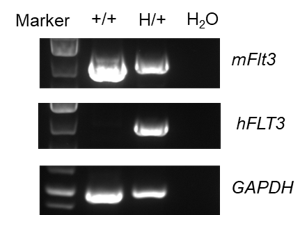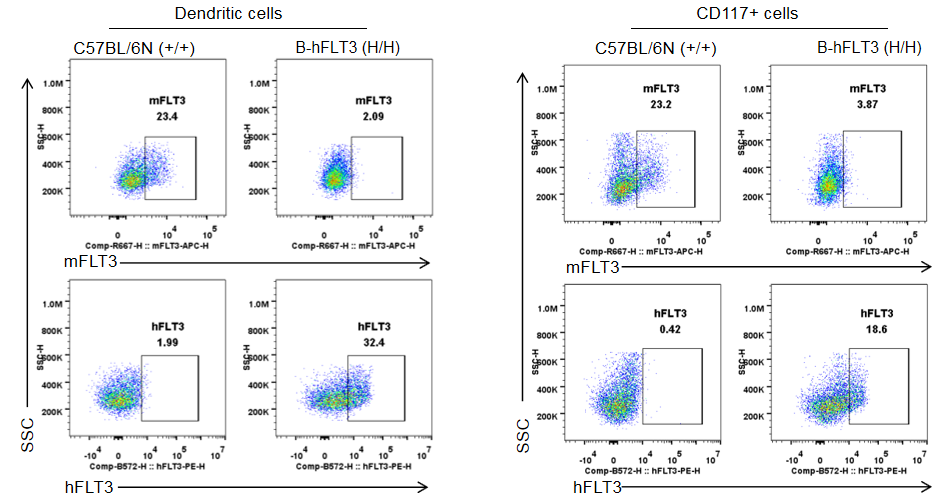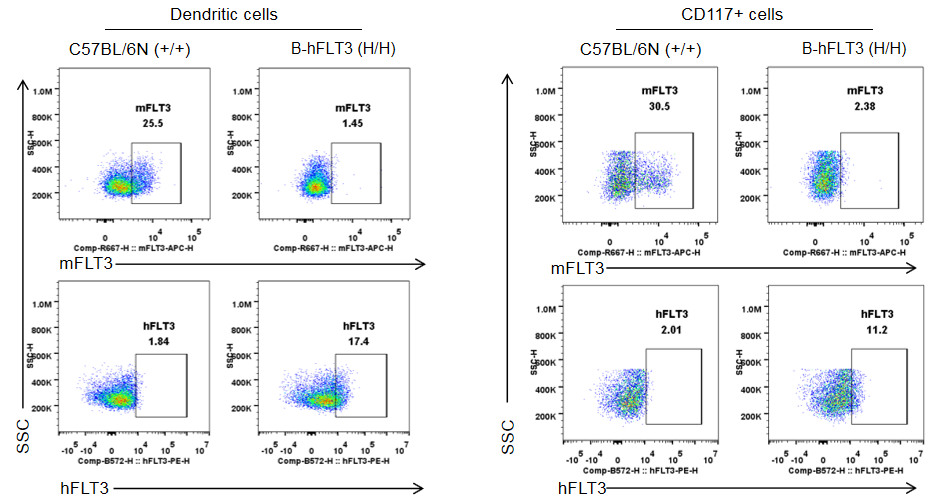B-hFLT3 mice
| Strain Name |
C57BL/6N-Flt3tm1(FLT3)Bcgen/Bcgen |
Common Name | B-hFLT3 mice |
| Background | C57BL/6N | Catalog number | 111318 |
|
Aliases |
CD135, FLK-2, FLK2, STK1 | ||
|
NCBI Gene ID |
2322 | ||
- FLT3, also known as Flk-2, Flt3, and Ly-72, is a type III tyrosine kinase receptor. It is expressed on the surface of many hematopoietic progenitor cells. Signaling of FLT3 is important for the normal development of hematopoietic stem cells and progenitor cells. Tyrosine-protein kinase that acts as a cell-surface receptor for the cytokine FLT3LG and regulates differentiation, proliferation and survival of hematopoietic progenitor cells and of dendritic cells.
- A chimeric CDS that encodes human FLT3 extracellular domain, mouse Flt3 transmembrane and cytoplasmic domain, followed by mouse exon 2 is inserted right to replace the part of exon 2 of mouse Flt3 gene. The chimeric FLT3 protein expression will be driven by endogenous mouse Flt3 promoter, while mouse Flt3 gene transcription and translation will be disrupted.
- Human FLT3 was exclusively detectable in homozygous B-hFLT3 mice, but not in wild-type C57BL/6N mice.
Targeting strategy
Gene targeting strategy for B-hFLT3 mice. A chimeric CDS that encodes human FLT3 extracellular domain, mouse Flt3 transmembrane and cytoplasmic domain, followed by mouse exon 2 is inserted right to replace the part of exon 2 of mouse Flt3 gene. The chimeric FLT3 protein expression will be driven by endogenous mouse Flt3 promoter, while mouse Flt3 gene transcription and translation will be disrupted.

Strain specific analysis of FLT3 gene expression in wild-type C57BL/6N mice and heterozygous humanized B-hFLT3 mice by RT-PCR. Bone marrow RNA were isolated from wild-type C57BL/6N mice (+/+) and heterozygous B-hFLT3 mice (H/+). Mouse Flt3 mRNA was both detectable in wild-type and heterozygous B-hFLT3 mice. Human FLT3 mRNA was exclusively detectable in heterozygous B-hFLT3 mice but not in wild-type C57BL/6N mice.

Strain specific FLT3 expression analysis in wild-type C57BL/6N mice and homozygous humanized B-hFLT3 mice by flow cytometry. Splenocytes were collected from wild-type C57BL/6N mice (+/+) and homozygous B-hFLT3 mice (H/H) (male, 6-week-old, n=1). Protein expression was analyzed with anti-mouse FLT3 antibody (Biolegend, 135309) and anti-human FLT3 antibody (Biolegend, 313305) by flow cytometry. Mouse FLT3 was only detectable in wild-type C57BL/6N mice. Human FLT3 was exclusively detectable in homozygous B-hFLT3 mice, but not in wild-type C57BL/6N mice.

Strain specific FLT3 expression analysis in wild-type C57BL/6N mice and homozygous humanized B-hFLT3 mice by flow cytometry. Bone marrow were collected from wild-type C57BL/6N mice (+/+) and homozygous B-hFLT3 mice (H/H) (male, 6-week-old, n=1). Protein expression was analyzed with anti-mouse FLT3 antibody (Biolegend, 135309) and anti-human FLT3 antibody (Biolegend, 313305) by flow cytometry. Mouse FLT3 was only detectable in wild-type C57BL/6N mice. Human FLT3 was exclusively detectable in homozygous B-hFLT3 mice, but not in wild-type C57BL/6N mice.









